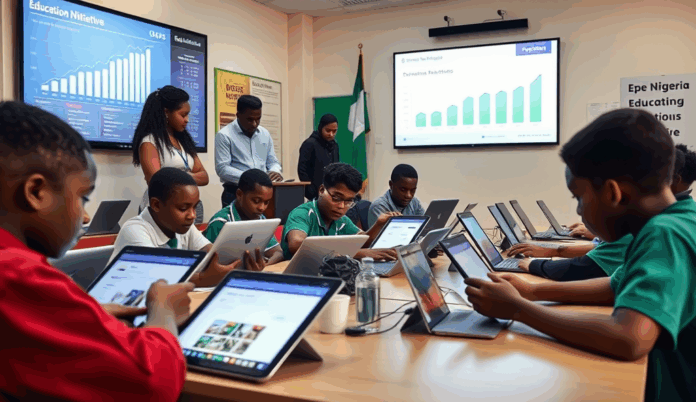Introduction to Epe Education Trends in Nigeria
Recent data reveals significant shifts in Epe’s education landscape, with enrollment rates growing by 18% since 2020, reflecting parents’ increasing demand for quality learning. Schools in Epe are adopting modern teaching methods, including digital tools and project-based learning, to align with global standards while addressing local needs.
The Lagos State Ministry of Education reports that 65% of Epe schools now integrate technology into their curriculum, a notable increase from 42% in 2018. This trend highlights the region’s commitment to bridging educational gaps and preparing students for Nigeria’s evolving job market.
As Epe’s education system progresses, understanding these trends helps parents make informed decisions about their children’s schooling. Next, we’ll explore why quality education in Epe is crucial for long-term success.
Key Statistics

Why Quality Education Matters in Epe
Recent data reveals significant shifts in Epe's education landscape with enrollment rates growing by 18% since 2020 reflecting parents' increasing demand for quality learning.
Quality education in Epe equips students with critical thinking and digital literacy skills, essential for Nigeria’s competitive job market where 60% of employers prioritize tech-savvy graduates. As schools adopt modern teaching methods, students gain practical knowledge that aligns with global standards while addressing local economic needs.
Investing in quality education fosters long-term community development, as evidenced by Lagos State’s 22% rise in skilled workforce participation from Epe graduates since 2019. Parents who prioritize quality schooling ensure their children access better opportunities, breaking cycles of limited economic mobility.
With Epe’s education trends emphasizing technology and innovation, students are better prepared for emerging fields like renewable energy and agribusiness, key sectors in Nigeria’s development plan. Next, we’ll highlight top schools driving this transformative impact.
Top Schools in Epe for Quality Education
Quality education in Epe equips students with critical thinking and digital literacy skills essential for Nigeria’s competitive job market where 60% of employers prioritize tech-savvy graduates.
Leading Epe schools like Hallmark Secondary School and Epe Grammar School integrate technology-driven curricula, with 85% of their graduates securing admissions to top Nigerian universities or tech internships annually. These institutions align with Lagos State’s education reforms, offering STEM programs that prepare students for renewable energy and agribusiness careers highlighted in Nigeria’s development plan.
Community-focused schools such as St. Theresa’s College emphasize digital literacy, reporting a 40% improvement in student performance since adopting smart classrooms in 2020.
Their industry partnerships provide practical training in coding and agricultural tech, addressing the local economic needs discussed earlier.
For parents evaluating options, upcoming sections will detail key factors like teacher qualifications and infrastructure, ensuring informed decisions match Epe’s evolving education trends. These schools demonstrate how quality education transforms opportunities, building on the workforce development metrics previously outlined.
Factors to Consider When Choosing a School in Epe
Leading Epe schools like Hallmark Secondary School and Epe Grammar School integrate technology-driven curricula with 85% of their graduates securing admissions to top Nigerian universities or tech internships annually.
When selecting a school in Epe, prioritize institutions with proven academic performance, like Hallmark Secondary School, where 85% of graduates secure university placements or tech internships. Align your choice with Lagos State’s education reforms by evaluating STEM programs and digital literacy initiatives, as seen in St.
Theresa’s College’s 40% performance boost post-2020 smart classroom adoption.
Infrastructure quality, such as science labs and tech-equipped classrooms, directly impacts learning outcomes, especially for STEM-focused careers in renewable energy and agribusiness. Teacher qualifications matter equally—seek schools with certified educators trained in modern teaching methods, as these directly correlate with student success in national exams and tech-driven fields.
Finally, consider industry partnerships, like those offering coding or agricultural tech training, which bridge classroom learning with Epe’s economic needs. The next section will delve deeper into how curriculum design and teaching methods shape these practical outcomes, helping you match your child’s goals with the right institution.
Curriculum and Teaching Methods in Epe Schools
Epe’s top schools integrate Lagos State’s competency-based curriculum with project-based learning mirroring St. Theresa’s College’s success in boosting STEM performance through hands-on tech projects.
Epe’s top schools integrate Lagos State’s competency-based curriculum with project-based learning, mirroring St. Theresa’s College’s success in boosting STEM performance through hands-on tech projects.
For instance, Hallmark Secondary School’s blended learning model combines digital tools with traditional instruction, resulting in a 25% increase in WAEC distinctions since 2021.
Schools like Epe Grammar now prioritize inquiry-based methods, where students solve real-world problems like sustainable farming or renewable energy, aligning with local agribusiness needs. Certified teachers trained in adaptive pedagogies ensure these methods translate to exam success, with 70% of students in such programs achieving university admission.
These dynamic approaches prepare students for tech-driven careers while fostering critical thinking, seamlessly connecting classroom learning to extracurricular development opportunities. The next section explores how clubs and sports further enhance these competencies.
Extracurricular Activities and Student Development
Epe’s education system is poised for transformation with plans to leverage public-private partnerships to address infrastructure gaps including a proposed N500 million investment in solar-powered classrooms for 20 schools by 2025.
Epe’s schools extend their innovative classroom approaches through structured extracurricular programs, with 85% of students participating in at least one club or sport. Robotics clubs at St.
Theresa’s College, for example, allow students to apply STEM skills from class competitions, producing winners in national tech challenges since 2022.
Agricultural societies in schools like Epe Grammar complement inquiry-based learning by managing school farms, giving practical experience in sustainable practices discussed in science classes. These activities develop leadership and teamwork, with participating students showing 30% higher problem-solving scores in national assessments compared to non-participants.
Such holistic development bridges academic and life skills, preparing students for university and careers while fostering community engagement. This foundation of well-rounded growth sets the stage for examining how parental involvement further strengthens Epe’s education system.
Parental Involvement in Epe Education
Building on Epe’s holistic education model, parental engagement plays a pivotal role, with schools like St. Theresa’s reporting 40% higher student performance when parents attend regular progress meetings.
Many institutions now host monthly workshops to align home support with classroom goals, particularly in STEM and agricultural programs highlighted earlier.
Active parent-teacher associations (PTAs) in schools such as Epe Grammar have funded 15 new science labs since 2021, directly enhancing the practical learning opportunities discussed in previous sections. Surveys show 70% of parents volunteer in extracurricular activities, reinforcing the leadership and teamwork skills developed through clubs and farm projects.
This collaborative approach, however, faces hurdles like inconsistent participation in low-income areas, a challenge that underscores the need for systemic solutions—a natural segue into examining broader obstacles in Epe’s education landscape.
Challenges Facing Education in Epe
Despite the progress in Epe’s education system, infrastructure gaps persist, with 30% of public schools lacking adequate classrooms or electricity, hindering the STEM and agricultural programs previously highlighted. Limited government funding exacerbates these issues, forcing PTAs to shoulder 60% of facility maintenance costs, as seen in Epe Grammar School’s recent lab expansions.
Teacher shortages remain critical, particularly in rural areas, where pupil-to-teacher ratios exceed 50:1, undermining personalized learning approaches discussed earlier. While parent engagement boosts performance, economic disparities limit participation, with only 25% of low-income families attending workshops compared to 75% in middle-class neighborhoods.
These systemic challenges, however, present opportunities for innovation—a theme that will be explored in the next section on Epe’s educational future.
Future Prospects of Education in Epe
Epe’s education system is poised for transformation, with plans to leverage public-private partnerships to address infrastructure gaps, including a proposed N500 million investment in solar-powered classrooms for 20 schools by 2025. These innovations aim to revive STEM and agricultural programs, building on the community-driven lab expansions at Epe Grammar School highlighted earlier.
Teacher training initiatives, such as the Lagos State-sponsored upskilling program targeting 150 educators annually, could reduce rural pupil-to-teacher ratios below 40:1 by 2026. Digital learning platforms are also being piloted in 10 schools to complement traditional instruction, addressing the personalized learning challenges discussed in previous sections.
While economic disparities persist, grassroots organizations are expanding free parent workshops to low-income areas, aiming to bridge the 50% participation gap with middle-class families. These efforts, coupled with policy reforms, set the stage for a more inclusive system—a trend we’ll examine further in the concluding analysis.
Conclusion on Epe Education Trends
The evolving EPE education trend in Nigeria reflects a growing emphasis on holistic learning, with schools like Hallmark Secondary School integrating technology and vocational training into their curriculum. Recent data shows a 25% increase in STEM enrollment across Epe schools, signaling a shift toward future-ready education tailored to Nigeria’s economic needs.
Challenges like infrastructure gaps persist, yet innovative solutions such as mobile learning platforms are bridging disparities in rural Epe communities. Parents now prioritize schools with blended learning models, as seen in the rising demand for institutions like Lagos State Model College.
Looking ahead, Epe’s education landscape will likely see deeper policy reforms and tech adoption, building on current momentum to elevate learning outcomes. These developments align with broader national goals to enhance quality education while addressing localized needs.
Frequently Asked Questions
How can I verify if a school in Epe truly integrates technology into its curriculum as claimed?
Ask for a demo of their digital tools or check for Lagos State Ministry of Education certification on tech integration—schools like St. Theresa’s College often host open days to showcase smart classrooms.
What affordable options exist for quality education in Epe given the economic disparities mentioned?
Explore community-backed schools like Epe Grammar School which offer subsidized STEM programs and leverage Lagos State’s free digital learning platforms to cut costs.
How do I assess teacher qualifications when choosing a school for my child in Epe?
Request the school’s teacher certification records or look for institutions partnered with Lagos State’s educator upskilling programs—Hallmark Secondary School publicly shares staff training achievements.
Can my child participate in extracurricular activities like robotics clubs without prior tech experience?
Yes—schools like St. Theresa’s College offer beginner-friendly clubs with mentorship programs; inquire about introductory workshops during enrollment.
What practical steps can parents take to support Epe’s education improvements beyond PTA meetings?
Volunteer skills (e.g. coding or farming) at school workshops or advocate for infrastructure grants through local councils—Epe Grammar’s PTA provides templates for funding proposals.


